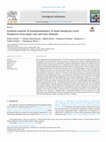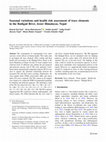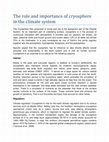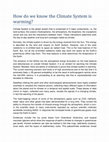Papers by Kshitiz M Kandel

Sustainable Agriculture Research , 2025
The growing number of agro-vets in Nepal reflects an increasing demand for pesticides, highlighti... more The growing number of agro-vets in Nepal reflects an increasing demand for pesticides, highlighting the need to investigate the types, toxicity, and public awareness of associated hazards. This study collected data from the oldest agro-vet in Kathmandu Valley, documenting the specific pesticides used. Although the data on pesticide volume is limited, the study is significant as it was carried out with limited research resources, both using synthesis data and primary data over a decade ago. The data was systematically organized in MS-Excel to provide a detailed overview of each pesticide. Additionally, the study examined the anthropogenic footprint, focusing on human activities such as population density and agricultural practices. The population size was plotted by calculating the overall population of districts touched by the river basins, extracted from the census. The percentage of gross national product was presented graphically to illustrate the anthropogenic features in each basin from high mountain terrain to lowlands. The lower sections of Nepal's Himalayan rivers and the middle segments of the Bagmati River face significant human and agricultural pressures, exacerbated by the widespread use of hazardous pesticides in Kathmandu, necessitating stringent regulatory actions, regular monitoring programs, and enhanced research efforts to assess and mitigate associated risks. These findings shed light on the historical background of the introduction of pesticides in Nepal and the most common types of pesticide in the Kathmandu valley, while the analysis of anthropogenic footprints offer a framework for evaluating human-induced impacts on the Himalayan freshwater systems of Nepal.
Concentration, Seasonality, and Sources of Trace Elements in Atmospheric Aerosols from Godavari in the Southern Himalayas

Ecological Indicators, 2024
Rivers originating from the Himalayas play a crucial role as primary water sources for a signific... more Rivers originating from the Himalayas play a crucial role as primary water sources for a significant proportion of the population in Asia downstream. This paper presents a comprehensive synthesis of hydrogeochemical data, incorporating major ions and trace elements from 153 papers spanning 2000 to 2023, with a detailed analysis of 20 papers specific to Nepal Himalayan rivers. To bridge the research gap due to sparse data, we aimed to enhance inclusivity by amalgamating both seasonal and one-time datasets, computing mean values for singular instances, and employing grand means for multiple seasonal data points. Our findings highlight varied research attention across different river basins, with the eastern Koshi Basin receiving extensive attention, while the middle Gandaki and Bagmati Basins garner moderate attention, and data scarcity observed in the western Karnali Basin. Predominant ionic composition, notably Ca 2+ and HCO 3-, reflect lithological influences, primarily driven by rock weathering. Although anthropogenic impacts remain minimal in most basins, certain lowland areas with higher population densities exhibit increasing significance. Trace element contamination, notably Cd, Cu, Sr, and Zn, poses ongoing threats, both from natural and anthropogenic sources. Water quality assessments conducted for agricultural and drinking suitability indicated good status, except in the densely polluted urban Bagmati stem. Health and ecological risks are low, as determined by pollution indices such as Pi, NPI, HI, and CI. The Bagmati River's middle segment, with high population density and moderate agricultural activity, shows pronounced anthropogenic footprints, while downstream areas exhibited greater impacts. Additionally, this article proposes the potential use of a Water Quality Index tool to comprehensively assess water quality across all parameters in Himalayan water bodies, providing a roadmap for future environmental conservation in the Himalayas. This pioneering review represents a significant effort to understand Himalayan rivers geochemistry on a large geographical scale and emphasizes the need for integrated observation and consideration of river water quality across the entire Himalayan region, from high mountains to lowlands.
Concentration, Seasonality, and Sources of Trace Elements in Atmospheric Aerosols from Godavari in the Southern Himalayas

Acta geochimica, Apr 28, 2023
The consumption of contaminated river water can have severe effects on human health. This study a... more The consumption of contaminated river water can have severe effects on human health. This study aims to investigate the trace elements (TEs) content and their health risk assessment in the Badigad River Basin in the lesser Himalayas of Nepal. In total, 44 water samples were collected from 22 different sites during the pre-monsoon and monsoon seasons, and 25 TEs were analyzed. Correlation matrix and principal component analysis (PCA) were used to analyze the potential relationship between the measured TEs and their source tracking. Furthermore, the water quality index (WQI), metal index (MI), and cancer index (CI) were evaluated. The TEs content in all samples were found to be within the WHO recommended guideline for drinking and domestic purposes. The dominancy order of the TEs was observed as Sr[Ba[Li[Rb[Zn[Cr[ Sc[Mn[Ti[Cu[As[Ni[Co[U[V[Pb[Cs[ Ga[Y[Tl[Th[Zr[Bi[Cd[Nb. The PCA analysis suggested that TEs could have natural, anthropogenic, and mixed origins. The WQI indicated that the river water is safe from a human health perspective. The MI suggested that Badigad River can be considered safer for drinking purposes, and the cancer index (CI) showed that all the reported TEs are at low-risk levels. The findings of this study could be useful for government agencies in developing more sustainable water management policies in the region. However, it is suggested that further investigations should be conducted in terms of other hydrogeochemical variables, including major ions, at spatiotemporal levels for the sustainability of the river basin.

Glacial record of trace metal pollution over the Central Himalayas and its surroundings: Distribution, variation, and anthropogenic signals
Glaciochemical records serve as one of the best archives and as good proxies to indicate regional... more Glaciochemical records serve as one of the best archives and as good proxies to indicate regional and global anthropogenic influences. The Himalayas, with fragile ecosystems and pristine environments, hold the third largest reservoir of glacier ice and represent an ideal region to investigate trace metal pollution using glacier records. Limited studies on glacially recorded trace metals in the Himalayas usually collect samples from individual glaciers and report a few trace metals in different seasons. We provide a comprehensive and in-depth understanding of the glacially recorded trace metals in the central Himalayas regarding their spatial distribution, seasonal variability, and anthropogenic signals. We analyzed six representative metals (Cu, Zn, Cd, Cr, Pb, Co) and found that the trace metal concentration range largely varied between the studied metals and sampling sites. The Zn metal concentration is higher, attributed to the contribution of natural sources (e.g., forest fires,...
Mercury variation and export in trans-Himalayan rivers: Insights from field observations in the Koshi River
Science of The Total Environment
The following report gives an overview on our group’s trip to Solambu, having the main purpose of... more The following report gives an overview on our group’s trip to Solambu, having the main purpose of finding out more about local waste management strategies and creating awareness towards a sustainable treatment of garbage. This document includes a description of our activities and actions undertaken, outcomes achieved, challenges faced as well as the budget required.
Drafts by Kshitiz M Kandel
This is an article about the relationship between COVID-19 and Climate change. This article illus... more This is an article about the relationship between COVID-19 and Climate change. This article illustrates why the pandemic and climate change crises must be treated equally. We must rise of these crises equally.

The Cryosphere that composed of (snow and ice) is the signigicant part of the Cliamte System. As ... more The Cryosphere that composed of (snow and ice) is the signigicant part of the Cliamte System. As an important part of underlying surface, cryosphere is in the process of continuous interaction with atmosphere. It includes sea ice, glaciers, ice sheets, ice caps, seasonal snow and frozen ground and covers about 1.8% of all water but almost 70% of the freshwater. It is also considered as one of Earth's five prime regimes together with the atmosphere, hydrosphere, biosphere, and the pedosphere. Specific aspect that the cryosphere has its influence on also directly affects overall activities and sustainability of the earth system and is vital for human survival. Cryosphere is an essential to our planet for the following reasons: Habitat: Mostly in the polar and sub-polar regions, in addition to human's settlements, the cryosphere also maintains crucial habitats for endemic microorganisms, algae, crustaceans, sea birds (both migratory and native), polar bears, penguins, seals, walruses, and whales (UNEP, 2007). It serves as a large space for various habitat facilities for local species and migratory populations in cold zones all over the world. Another important service is the cryosphere water, which promotes the circulation of cold and warm ocean currents in high latitudes regions as they flow into the ocean. The phenomenon proceeds as the cold and warm ocean currents intersect, it causes disturbance in the seawater (the deep water escalates and the near-surface seawater sinks). There is a circulation of nutrients as the seawater that flows to the surface carries nutrients to the surface of the ocean. These nutrients feed and enhance the growth of planktons. This in turn flourishes the basic food sources for other fishes.

Climate System is the global system that is comprised of 5 major components, i.e. the land surfac... more Climate System is the global system that is comprised of 5 major components, i.e. the land surface, the oceans (Hydrosphere), the atmosphere, the biosphere, the cryosphere (snow and ice) and the interactions between them. These interactions determine both the day-today weather and long term averages called as climate. Normally, the climate system is driven by the energy received from the Sun. The energy is absorbed by the land and oceans on Earth System. However, rest of the solar radiations is re-emitted back to space as radiant heat. This is the heat balance of the Earth. But, not all the re-emitted radiations make way back into space as the Earth's greenhouse effect trap them. This heat balance is what determines the temperature of the Earth. The emission of the GHGs into the atmosphere brings fluctuation on the heat balance and disturbances on overall Climate System. It is an evident for warming the Climate System. Besides, there are plenty of evidences to prove that climate system is warming. The current warming scenario and trend is of high prominence due to the fact that it is extremely likely (> 95 percent probability) to be the result of anthropogenic activity since the mid-20th century. It is proceeding at an alarming rate that is unprecedented over decades to millennia. Satellites orbiting the earth and other technological advancements have highly enabled scientists to visualize the massive picture, collecting many different types of information about the planet and its climate on a temporal and spatial scale. These pieces of data (minor to major), collected over many years, reveals the signals of a changing climate, in fact the warming of the planet. The heat-trapping nature of some of the atmospheric gases such as CO2, methane, water vapor and other gases has been demonstrated for a long time. They consist the ability to influence the transfer of infrared energy through the atmosphere, which in turn, is the scientific basis of many instruments operated by various scientific institutes worldwide including NASA. In response the increased levels of greenhouse gases must cause the Earth to warm. Evidences include the ice cores drawn from Greenland, Antarctica, and tropical mountain glaciers which show the response of earth's climate to changes in greenhouse gas levels. Ancient evidence can also be tracked in the tree rings, sediments (oceans), coral reefs, and the layers of sedimentary rocks. This paleoclimate evidences reveal
The growing number of agro vets in Kathmandu valley could only mean one thing; the growing demand... more The growing number of agro vets in Kathmandu valley could only mean one thing; the growing demand and use of pesticides. So, it became necessary to find out what pesticides are being used, their degree of toxicity and also if the people were aware about their hazards. In the process, data was collected from the oldest agro vet in the valley and few questions were asked about the pesticides. Detailed information about each pesticide was tabulated in excel. Overall, the information and data provided a new perception about the use and misuse of pesticides. Introduction:








Uploads
Papers by Kshitiz M Kandel
Drafts by Kshitiz M Kandel